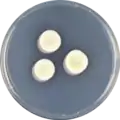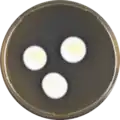| Aspergillus biplanus | |
|---|---|
| Scientific classification | |
| Domain: | Eukaryota |
| Kingdom: | Fungi |
| Division: | Ascomycota |
| Class: | Eurotiomycetes |
| Order: | Eurotiales |
| Family: | Aspergillaceae |
| Genus: | Aspergillus |
| Species: | A. biplanus |
| Binomial name | |
| Aspergillus biplanus | |
| Type strain | |
| ATCC 16858, CBS 468.65, IMI 235602, NRRL 5071, NRRL MOLD 5071, QM 8873, WB 5071[4] | |
Aspergillus biplanus is a species of fungus in the genus Aspergillus. It is from the Sparsi section.[5][6] The species was first described in 1965.[1] It has been isolated from soil in Costa Rica.[5] It has been reported to produce auroglaucin.[5]
Growth and morphology
A. biplanus has been cultivated on both Czapek yeast extract agar (CYA) plates and Malt Extract Agar Oxoid® (MEAOX) plates. The growth morphology of the colonies can be seen in the pictures below.
 Aspergillus biplanus growing on CYA plate
Aspergillus biplanus growing on CYA plate Aspergillus biplanus growing on MEAOX plate
Aspergillus biplanus growing on MEAOX plate
References
- 1 2 Raper, K.B.; Fennell, D.I. 1965. The Genus Aspergillus. :1-686
- ↑ "Aspergillus biplanus". www.mycobank.org.
- ↑ "A. biplanus | Aspergillus & Aspergillosis Website". www.aspergillus.org.uk.
- ↑ "Aspergillus biplanus". www.uniprot.org.
- 1 2 3 Varga, J.; Frisvad, J.C.; Samson, R.A. (2010). "Polyphasic taxonomy of Aspergillus section Sparsi". IMA Fungus. 1: 187–195. doi:10.1016/j.simyco.2016.10.001. PMC 5198626. PMID 28050053.
- ↑ Chen, A.J.; Frisvad, J.C.; Sun, B.D.; Varga, S.; Kocsubé, S.; Dijksterhuis, J.; Kim, D.H.; Hong, S.-B.; Houbraken, J.; Samson, R.A. (2016). "Aspergillus section Nidulantes (formerly Emericella): Polyphasic taxonomy, chemistry and biology". Studies in Mycology. 84: 1–118. doi:10.1016/j.simyco.2016.10.001. PMC 5198626. PMID 28050053.
Further reading
- Machida, Masayuki; Gomi, Katsuya (2010). Aspergillus: Molecular Biology and Genomics. Horizon Scientific Press. ISBN 9781904455530.
This article is issued from Wikipedia. The text is licensed under Creative Commons - Attribution - Sharealike. Additional terms may apply for the media files.